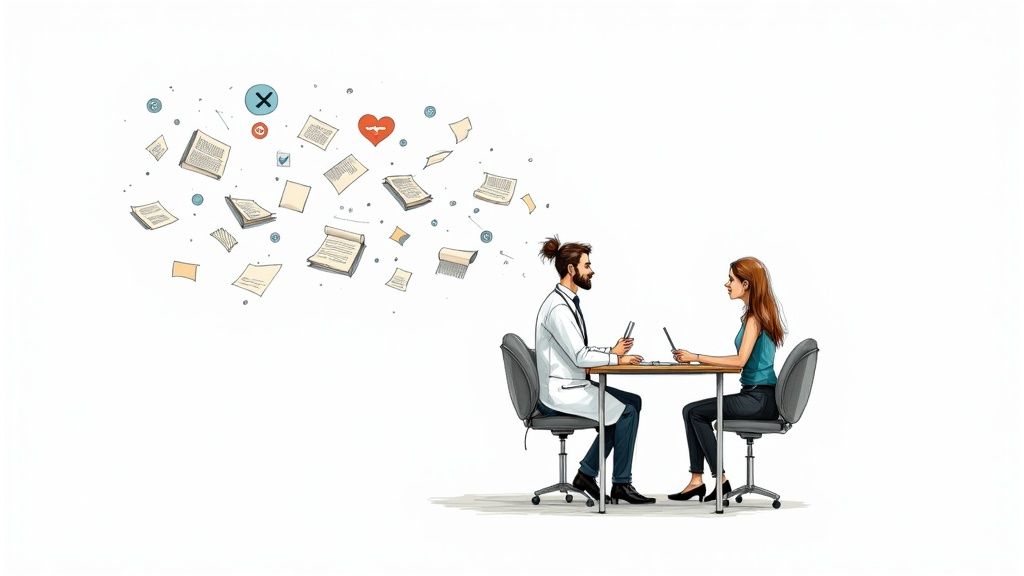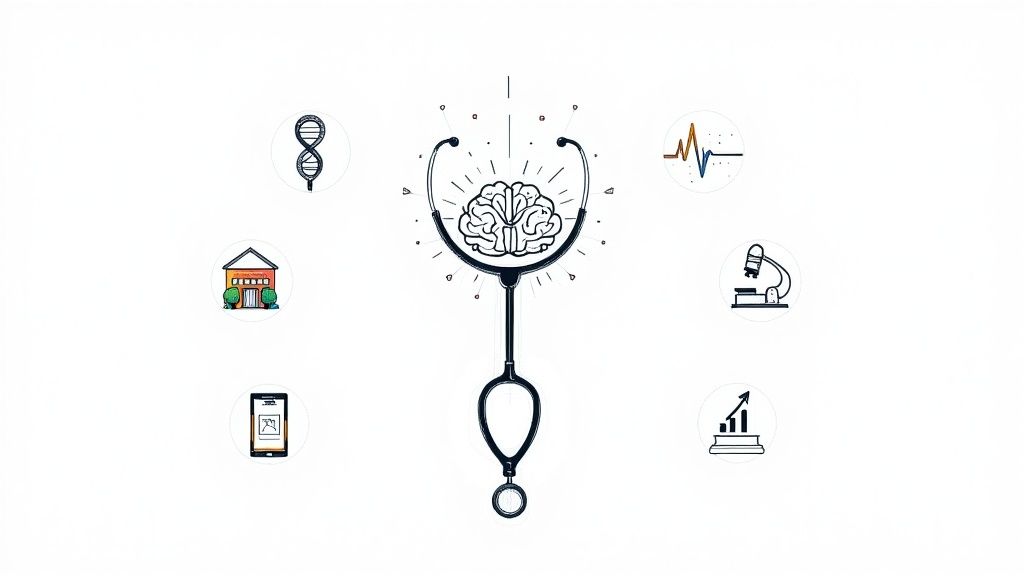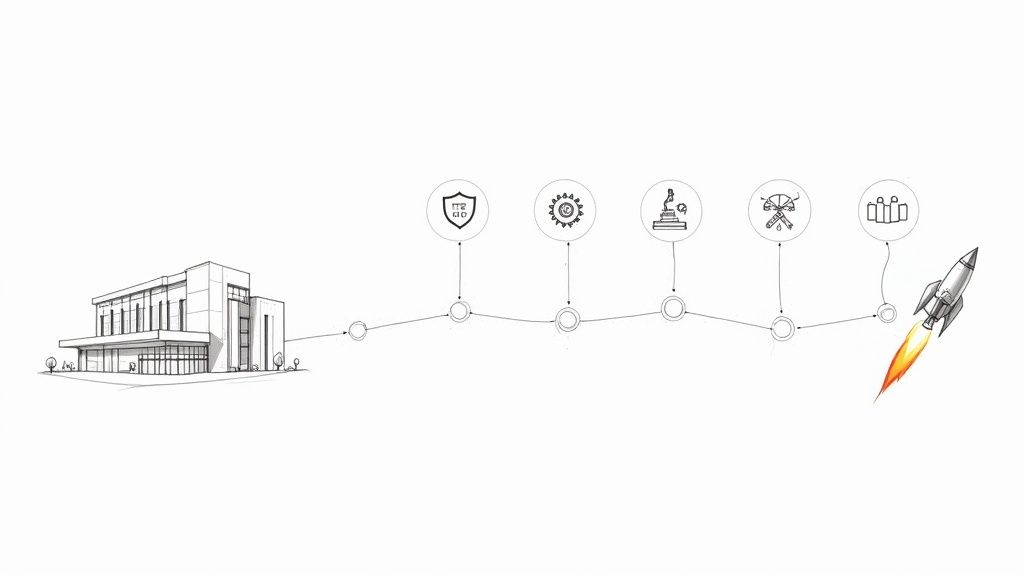AI and Human Collaboration The Ultimate Guide
Unlock the power of AI and human collaboration. This guide explores hybrid intelligence, real-world use cases, and strategies to boost productivity.
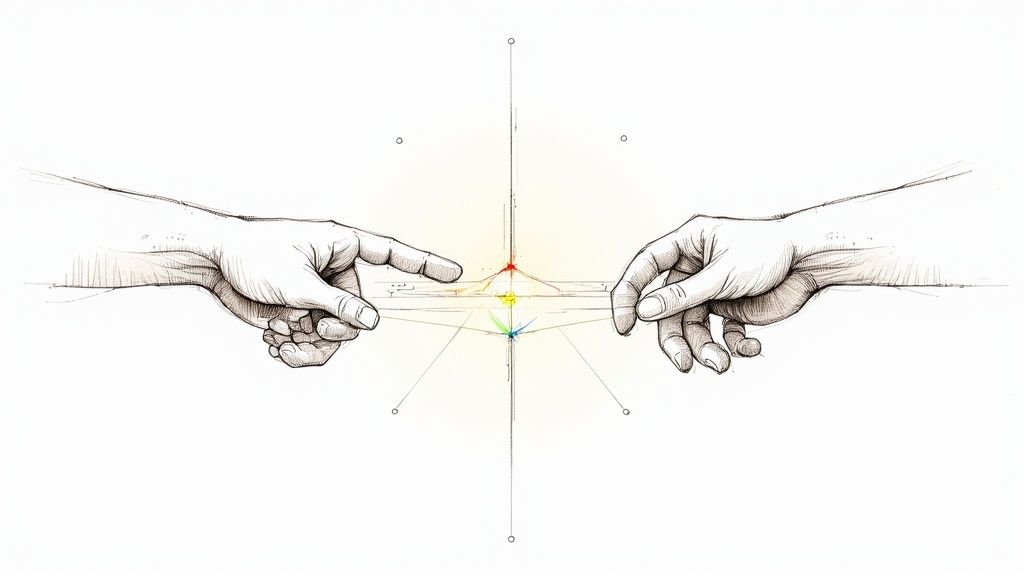
Forget the talk of robots taking over. The real story, the one that’s actually unfolding in modern workplaces, is about partnership. This isn't about replacing people; it's about AI and human collaboration augmenting our abilities. It's a powerful synergy where human intuition guides machine-level analysis to create results that neither could achieve alone.
The New Power Couple: Human Insight and AI Precision
One of the biggest myths about artificial intelligence in business is this idea of a takeover. The reality is far more interesting and, frankly, much more productive. Instead of a battle for dominance, the most successful approach is a dynamic partnership that blends the unique strengths of human intelligence with the processing power of machines.
Think of it like an experienced surgeon working with an advanced robotic arm. The surgeon brings years of judgment, the ability to adapt to unforeseen complications, and the critical human touch. The AI-powered robotic arm provides incredible precision, steadiness, and the ability to execute movements beyond human physical limits. The surgeon is always in control, making the critical decisions, while the technology enhances their skill to deliver a better outcome.
This kind of collaboration is reshaping entire industries by amplifying our most valuable skills, not rendering them obsolete. This is the very essence of AI co creation, a model where human insight directs the incredible analytical power of technology toward a shared goal.
The Foundation of a Successful Partnership
At its core, a successful collaboration between humans and AI hinges on a simple principle: understanding what each side brings to the table. We humans excel at grasping nuanced context, applying ethical judgment, and thinking outside the box. AI, on the other hand, is brilliant at sifting through mountains of data, spotting subtle patterns we might miss, and performing repetitive tasks with perfect consistency and speed.
This is more than just a simple division of labour; it's an interactive and dynamic process.
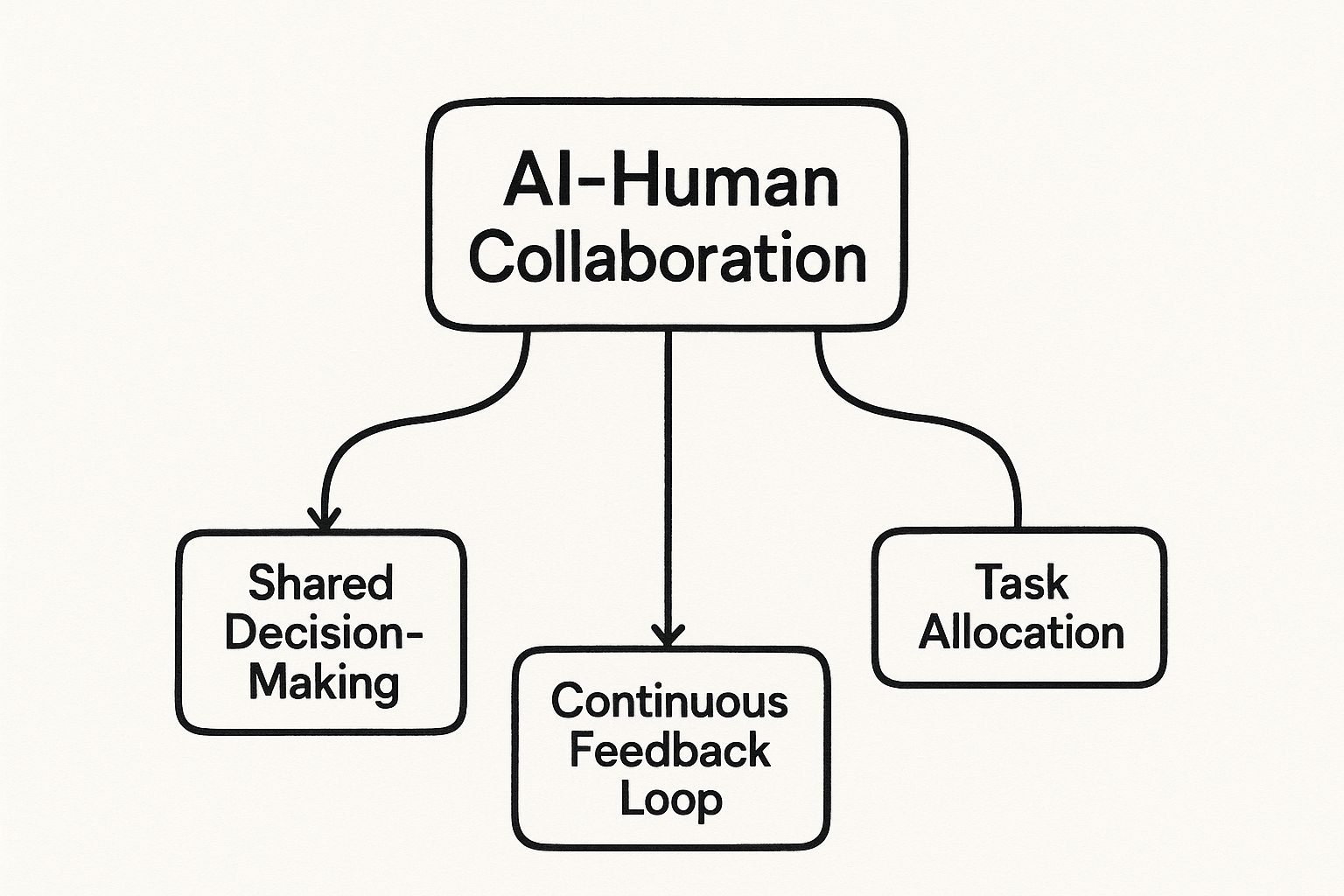
As the diagram shows, a strong partnership isn't static. It's a continuous loop of shared decision-making, intelligent task allocation, and constant feedback, where each partner learns from and improves the other.
When these roles are clearly defined and smoothly integrated, a business can move beyond basic automation and tap into true hybrid intelligence. To really understand this, it helps to see the strengths side-by-side.
Human vs AI Strengths in a Collaborative Framework
The table below breaks down the complementary capabilities that make this partnership so effective. It’s not about who is "better," but how their different skills combine to create a more powerful whole.
Capability Human Strength AI Strength
Problem-Solving
Creative, contextual, and strategic thinking; ethical judgment.
Data-driven analysis, pattern recognition, and simulation of outcomes.
Decision-Making
Intuitive understanding, empathy, and long-term strategic vision.
Rapid analysis of massive datasets, identifying correlations, and providing evidence-based recommendations.
Execution
Adaptability in novel situations, complex negotiation, and leadership.
High-speed, high-volume task completion with unparalleled accuracy and consistency.
Learning
Conceptual understanding, skill transference, and applying wisdom from experience.
Continuous improvement through data ingestion, identifying new patterns, and refining algorithms over time.
By building a strategy that plays to these distinct strengths, organisations can create a truly collaborative future where human and machine intelligence work in concert for maximum impact.
Why Hybrid Intelligence Is a Competitive Advantage
Combining human and artificial intelligence isn't just about tweaking efficiency; it's a fundamental shift that gives businesses a serious competitive edge. This partnership, what many of us call hybrid intelligence, allows teams to tackle problems that were once too complex or just too resource-intensive to even consider.
Think about it this way: when you let AI handle the heavy lifting of data analysis and spotting patterns, your experts are free to do what people do best. They can dedicate their time to high-level strategy, creative problem-solving, and providing the ethical oversight that machines simply can't. That’s where real growth and market differentiation happen.
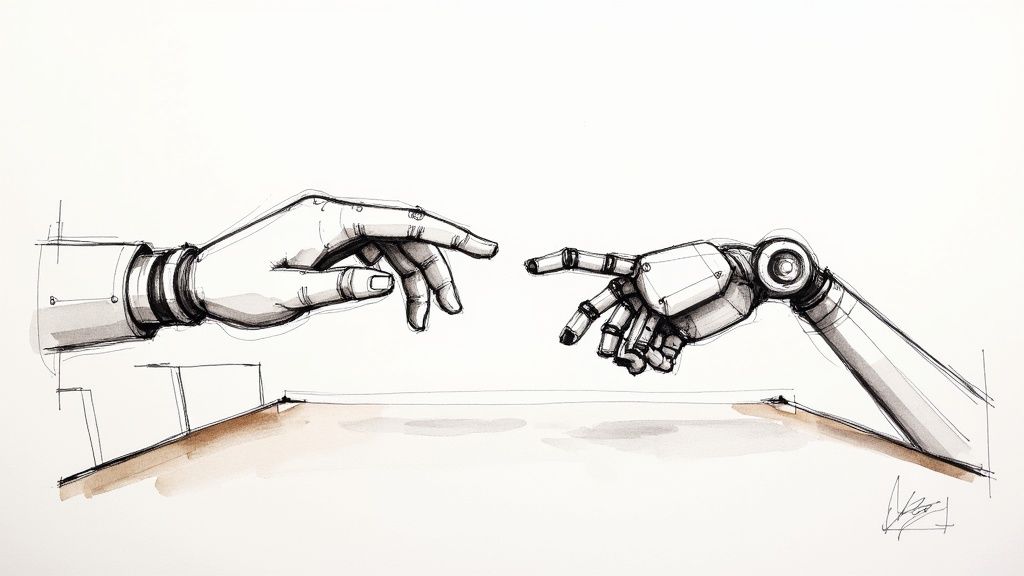
This synergy delivers concrete business results. Decisions become faster and more accurate because they're backed by data analysis on a scale no human team could match in the same time.
By blending human intuition with machine precision, organisations can drastically reduce errors, boost productivity, and discover new revenue streams buried deep within their data. This approach fosters a culture of continuous learning and adaptation, making the entire business more resilient in a fast-changing market.
From National Strategy to Business Wins
You can see the power of this collaborative model playing out on a national scale. Germany, for example, is zeroing in on AI solutions designed for its industrial powerhouses like manufacturing and automotive. Instead of chasing generic platforms, they’re embedding AI right where their deep human expertise already lives.
This targeted approach amplifies their existing competitive strengths and shows how AI and human collaboration can build real economic muscle. This focus is a cornerstone of Germany’s ambition to lead in AI, with its generative AI market expected to reach roughly US$2.77 billion by the end of 2025.
This national-level blueprint offers a fantastic lesson for individual companies. The real advantage isn't found by sprinkling AI everywhere, but by pinpointing the specific areas where machine intelligence can supercharge the high-value skills of your team. It’s all about a thoughtful approach to find where this partnership will deliver the biggest impact.
Building Your Strategic Advantage
To get there, organisations need to move past simply buying new tools and start building a proper strategy. The aim is to create a seamless workflow where AI insights flow naturally into human decision-making. This requires a clear plan that connects the technology directly to your business goals.
A solid plan should map out exactly how AI will support different teams and roles, making sure the technology serves the business, not the other way around. A robust AI strategy framework is crucial for guiding everything from which tools to choose to how you’ll integrate and measure success.
The companies that truly succeed see AI not as a replacement for their people, but as a powerful partner that sharpens their competitive instincts. By deliberately cultivating this hybrid intelligence model, you build an organisation that isn’t just more efficient—it's smarter, more innovative, and ready for whatever comes next.
Building Your Collaborative Intelligence Framework
Successfully blending AI with human talent is about more than just plugging in new software. It takes a deliberate, well-thought-out plan. A powerful AI and human collaboration doesn’t just happen; it’s designed, built, and nurtured. Think of it as a blueprint for your business, guiding everything from the tech you choose to how you train your teams. This framework is what turns the idea of collaboration into a real-world asset.
The first step? Move away from vague concepts and get specific. You need to pinpoint exactly where this synergy will make the biggest difference. It's not about throwing AI at every problem. It's about being smart. Maybe the goal is to slash product development time, fine-tune your supply chain, or create a customer service experience that feels almost psychic in its responsiveness.
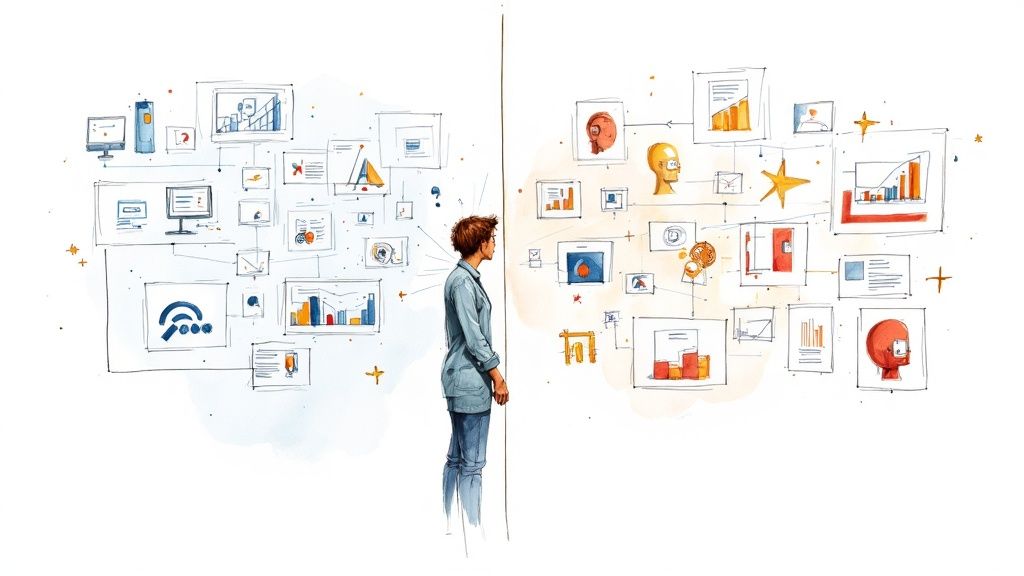
Once you have those clear goals, you can start mapping out the processes that will bring them to life. For a hands-on look at getting your team aligned and sparking new ideas, our guide on planning an AI strategy workshop is a great place to start.
Laying the Strategic Foundation
Knowing what you want to accomplish is one thing. Knowing how you'll get there is another. This is where a solid AI strategy comes into play. It’s the rulebook for your entire initiative, making sure every decision pushes you closer to your main objectives.
A well-crafted framework needs to cover a few critical areas:
- Technology Governance: Which AI tools are the right fit for your goals? This means looking at different platforms and judging them on how they scale, their security, and how easily they’ll slot into the systems you already use.
- Data Strategy: Data is the fuel for AI. Your plan must detail how you’ll gather, manage, and protect the high-quality data your AI models need to learn and perform.
- Workflow Redesign: This is where you draw the map of how people and AI will work together. You need to define the hand-off points, who makes the final call, and how feedback will flow. This creates a loop where humans teach the AI and the AI, in turn, provides valuable insights back to the humans.
Cultivating the Human Element
Technology is only half the picture. You could have the most sophisticated AI in the world, but if your team doesn't trust it or know how to use it, it's useless. The human side of this equation is absolutely critical, and it calls for careful change management.
The real aim is to foster a culture where employees view AI not as a replacement, but as a powerful partner that helps them do their jobs better and with more impact. Getting this cultural shift right is the bedrock of any successful AI-human team-up.
Creating this kind of environment takes work. You have to clearly communicate why these changes are happening, focusing on the upsides for both the company and for individuals. It also means creating a space where people feel safe to experiment and even fail on a small scale. This builds the confidence and trust that are the true currency of any strong partnership.
From Pilot to Scale
Once your framework is solid and your team is ready for the shift, it's time to start small with a pilot project. Pick a use case that is well-defined, low-risk, and has the potential for high impact. This is your chance to test your new workflows, measure the results, and collect feedback without turning the whole organisation upside down.
Be sure to define your Key Performance Indicators (KPIs) right from the get-go. Are you trying to cut down customer issue resolution times, boost sales conversions, or improve the accuracy of a diagnostic process? Having these metrics gives you the hard evidence you’ll need to make the case for expanding the initiative.
A successful pilot project creates momentum and teaches you invaluable lessons for a wider roll-out. This is the most reliable way to weave collaborative intelligence into the fabric of your organisation: start small, prove the value, and then scale your success.
Real World Examples of Hybrid Intelligence in Action
Theory is one thing, but seeing AI and human collaboration in practice is where you really grasp its value. Across various industries, this partnership isn't some far-off concept; it’s delivering tangible results today. Looking at these real-world use cases is the best way to see how hybrid intelligence goes from being a buzzword to a powerful operational reality.
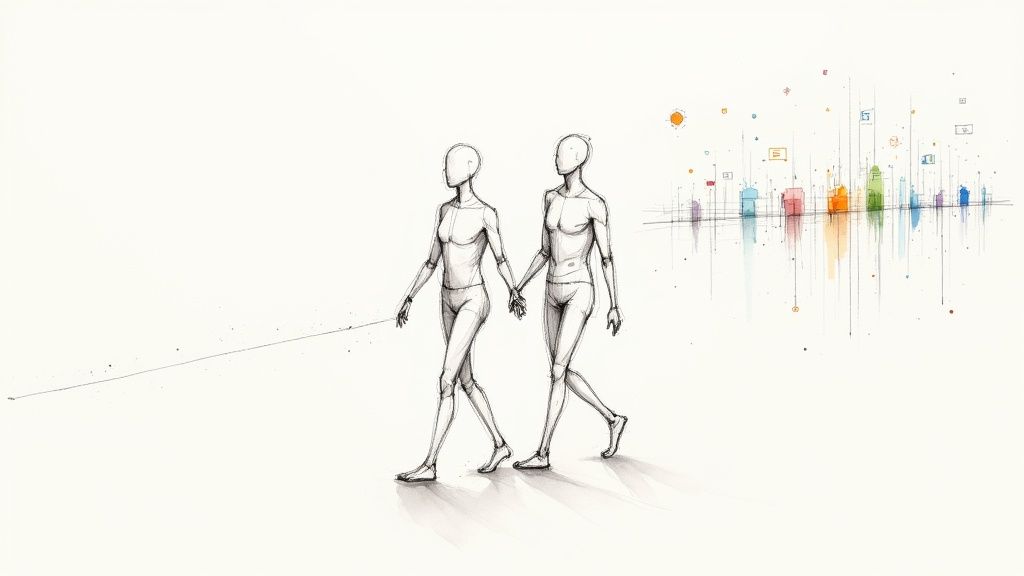
From medical diagnostics to creative design, the applications are as diverse as the problems businesses are trying to solve. Each example highlights a simple, core principle: AI supplies the brute-force analytical power, while humans bring the essential context, judgement, and strategic direction.
Transforming Healthcare Diagnostics
In healthcare, the stakes couldn't be higher, and accuracy is paramount. Radiologists spend their days poring over complex medical images like X-rays and MRIs, searching for tiny abnormalities. It’s an incredibly demanding job where fatigue can set in, and the sheer volume of scans can be overwhelming.
This is a perfect scenario for an AI-human partnership. AI algorithms, trained on millions of historical scans, can analyse new images in seconds. The system flags potential areas of concern—a subtle shadow that might be a tumour or early signs of disease—that a human might overlook on a first pass.
That’s when the radiologist steps in. They use their years of medical training to verify what the AI has found, dismiss any false positives, and ultimately make the final diagnosis. The AI doesn't replace the doctor; it acts as an incredibly vigilant assistant, leading to faster, more accurate diagnoses. This synergy is a brilliant example of AI and human collaboration improving patient outcomes.
Advancing Precision Health in Europe
This collaborative healthcare model is rapidly gaining ground, with Germany at the forefront. The country is building a solid foundation for AI-driven health innovations by creating massive data repositories. A key example is the upcoming Health Data Lab, which plans to offer secure access to health data from around 75 million insured individuals.
This huge data pool, a component of the broader European Health Data Space, enables AI systems to help clinicians and researchers personalise treatments and enhance health systems. The partnership between human medical expertise and AI-powered analytics is turning raw data into life-saving insights. You can find out more about how Germany is shaping AI-driven healthcare in this in-depth report.
Predictive Power in Manufacturing
In the manufacturing world, unplanned downtime is the ultimate enemy. When a vital piece of machinery fails, it can grind an entire production line to a halt, costing millions in lost revenue. This is where predictive maintenance, driven by a hybrid intelligence model, truly shines.
Sensors on factory equipment constantly stream data on performance, temperature, and vibration. An AI system monitors this flood of information in real-time, searching for the tiny deviations that signal an impending failure.
Instead of waiting for a breakdown, the AI alerts an engineering team with a specific warning: "Component B on machine 7 is showing wear patterns that indicate a 90% chance of failure within the next 72 hours."
This crucial heads-up gives the human team the time they need to act. The engineers can then schedule maintenance during a planned shutdown, order the right parts, and prevent a costly disruption before it ever happens. The AI tells them what is about to happen, and the human experts decide how and when to fix it.
Igniting Creativity in Content Creation
The creative fields might seem like the last bastion against AI, but even here, collaboration is sparking fresh ideas. Writers, designers, and marketers often struggle with the "blank page" or a creative block. Generative AI is quickly becoming a tireless brainstorming partner.
A writer can prompt an AI tool to generate dozens of headline ideas, explore different angles for a blog post, or even draft a basic outline. The AI provides the raw material and a starting point, breaking through that initial inertia. From there, the human writer takes over to refine, edit, and inject the nuance, storytelling, and unique voice that only a person can bring. It’s a classic case of AI co creation at its best.
Navigating the Challenges of AI Integration
Bringing AI into your team’s daily workflow is a massive step forward, but let's be realistic—it's not always a simple plug-and-play process. Blending artificial and human intelligence creates its own unique set of hurdles. The trick is to see these challenges not as stop signs, but as part of the journey.
Surprisingly, the biggest roadblocks often aren't the technical ones. Yes, things like data quality and system integration are tricky, but the human side of the equation—dealing with a natural resistance to change and setting up solid ethical rules for AI—is frequently the tougher nut to crack.
Addressing the Skills Gap
One of the first things you'll run into is the skills gap. When you change how work gets done, you also change the skills your team needs. People must learn to do more than just complete tasks; they need to manage, question, and fine-tune what the AI is doing. This requires a genuine commitment to training and development.
This isn't just about showing someone how to use a new piece of software. It’s about cultivating a whole new way of thinking. As we explored in our AI adoption guide, creating a culture where learning is constant is key to making this transition work for the long haul. The aim is to get your team ready for these new, more collaborative roles.
A proactive approach to upskilling transforms anxiety about change into excitement for what's next. When your team feels supported and equipped with new skills, they turn into advocates for the new hybrid model, not roadblocks.
Investing in your people always pays off. When it comes to building an AI-ready workforce, Germany is leading the pack in Europe, striking a good balance between the demand for AI skills and the supply of talent. For instance, while 26%-28% of AI-related jobs call for advanced skills, the pool of qualified professionals is around 18%-21%. This impressive alignment is fuelled by major investments in AI education, like new professorships and learning platforms built to connect human know-how with machine intelligence. You can get a deeper look into how Europe is managing the AI talent equation in this report.
Overcoming Technical and Ethical Hurdles
Beyond skills, you’ve got technical and ethical issues to think through. Trying to get shiny new AI tools to talk to your old legacy systems can be a headache, and making sure your data is clean is non-negotiable. Remember, with AI, it’s always garbage in, garbage out. A clear AI strategy framework is your best friend here, helping you make smart tech choices that actually support your business goals.
Just as important, you need to set up strong ethical guardrails. As AI starts handling more of the analytical heavy lifting, you need clear rules to ensure its decisions are fair, transparent, and accountable. This isn’t just about internal trust; it’s about maintaining the trust your customers have in you. By tackling these challenges with a smart strategy and a real focus on your people, you can build a powerful and resilient hybrid intelligence model.
Your Next Steps Toward a Hybrid Intelligence Future
The path toward weaving AI into your human teams isn't some far-off idea anymore—it's a practical necessity for any business that wants to stay relevant and competitive. If there's one thing to take away from this guide, it's this: success comes from augmenting your people, not replacing them. When we combine our uniquely human strengths—like creativity, empathy, and ethical reasoning—with AI's incredible power to process data, we build something far greater than the sum of its parts.
This partnership is where the magic happens. It turns raw data into real-world meaning and breaks down overwhelming challenges into solvable problems. Most importantly, it frees up your team to do the kind of high-value, strategic work that truly drives the business forward. We’ve already seen how this synergy is creating massive advantages in fields from healthcare to manufacturing. Now, it's your turn to start building.
Turning Strategy into Action
Getting started doesn't mean you need to rip up your current operations and start from scratch. Far from it. The best approach is to begin with a single, well-chosen pilot project. Pick an area where you can demonstrate a clear win and use that success to build momentum across the organisation.
A great first move is to conduct a detailed AI requirements analysis. This will help you pinpoint exactly where in your workflow an AI tool could make the biggest difference for your team. If you'd rather have an expert guide you through the process, bringing in an AI strategy consulting partner can give you the focused direction needed to ensure your technology investments line up perfectly with your business goals. For those looking for a hands-on solution, our AI Strategy consulting tool can also help streamline this process.
The most crucial step is the one you take right now. By actively shaping your collaborative intelligence strategy, you’re not just preparing for the future—you’re building a lasting competitive edge.
Creating this hybrid future is all about finding the right mix of technology and human insight. When you're ready to explore what's possible, connect with our expert team. We can talk through your specific challenges and map out how a smart partnership can unlock new levels of performance and innovation for your organisation.
Frequently Asked Questions About AI and Human Collaboration
Thinking about how to blend AI with your human team can bring up a lot of questions. We get it. To help clear things up, here are some straight-to-the-point answers to what we hear most often. For an even deeper dive, you can always check out our full FAQ page.
Will AI Make Human Skills Obsolete in a Collaborative Setting?
Quite the opposite, actually. The whole point of AI and human collaboration is to enhance human capabilities, not replace them. Think of AI as the ultimate assistant, perfectly suited for the repetitive, data-heavy lifting that bogs down your team. It handles the number-crunching and pattern-spotting with incredible speed.
This frees up your people to double down on what they do best: thinking strategically, coming up with creative solutions, connecting with customers, and making complex ethical judgements. In fact, it makes those uniquely human skills more valuable than ever, creating new responsibilities focused on guiding the AI and turning its insights into real-world action.
How Can a Small Business Afford to Start with AI Collaboration?
You don’t need a huge budget or an in-house team of data scientists to get started. The secret is to start small and be strategic. Pick one specific, nagging problem in your business—maybe it's sifting through customer support tickets or trying to make sense of your sales data.
Once you have a target, you can find a scalable, user-friendly AI tool designed for that exact job. Run a small pilot project with it. This lets you test the new process, measure the outcome, and see a clear return on your investment before you go all in. It’s a smart, lean way to build up your AI capabilities without a major upfront cost.
What Is the Most Critical Factor for a Successful AI-Human Partnership?
If you strip everything else away, the single most important element is your company culture. The most sophisticated technology in the world will fall flat if your team isn't on board. Success really comes down to building an environment of trust, where people feel safe to experiment and are encouraged to learn.
Leadership has to be crystal clear about why the company is bringing in AI, framing it as a tool that helps everyone do their job better. It’s about investing in your people through upskilling and creating feedback systems where humans can actively teach the AI to be better. Without a culture that truly welcomes this new way of working, you’ll never see the full benefits.
How Do You Ensure AI and Humans Work Together Effectively?
It all boils down to two things: clear roles and a smooth workflow. You have to design your processes so it’s obvious where the AI’s job ends and the human’s job begins. Typically, the AI will generate the initial data, analysis, or draft, and a person will step in to add context, check for accuracy, and make the final strategic call.
The tools themselves need to be intuitive and easy for your team to use. Just as important are ongoing training and open communication channels. This ensures everyone understands their part and can adapt together as the technology—and your business—evolves.
Ready to transform your team’s potential into a powerful competitive advantage? At Ekipa AI, we help you move from idea to impact. You can learn more about the experts who make it happen by visiting our team page.
Discover your AI opportunities with our tailored strategies today.

